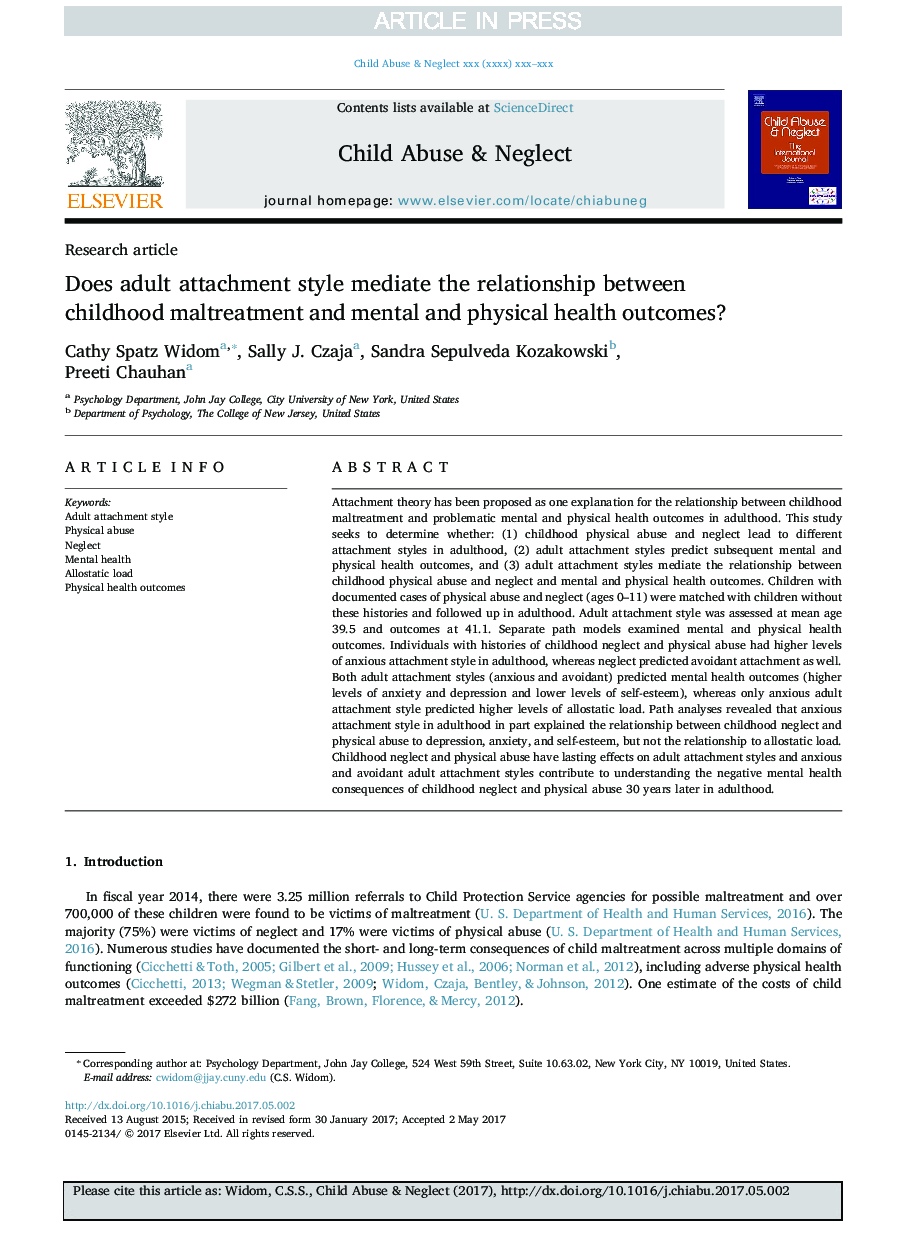| کد مقاله | کد نشریه | سال انتشار | مقاله انگلیسی | نسخه تمام متن |
|---|---|---|---|---|
| 6832205 | 1434352 | 2018 | 13 صفحه PDF | دانلود رایگان |
عنوان انگلیسی مقاله ISI
Does adult attachment style mediate the relationship between childhood maltreatment and mental and physical health outcomes?
ترجمه فارسی عنوان
آیا سبک دلبستگی بالاتری میان روابط میان بدرفتاری دوران کودکی و نتایج سلامت روان و فیزیکی میانجیگری می کند؟
دانلود مقاله + سفارش ترجمه
دانلود مقاله ISI انگلیسی
رایگان برای ایرانیان
کلمات کلیدی
ترجمه چکیده
نظریه پیوستن به عنوان یک توضیح برای رابطه بین بدرفتاری دوران کودکی و پیامدهای سلامت روانی و فیزیکی در بزرگسالان پیشنهاد شده است. این مطالعه به دنبال تعیین اینکه آیا: (1) سوء استفاده و غفلت فیزیکی در دوران کودکی منجر به سبک های دلبستگی متفاوت در بزرگسالی می شود؛ (2) سبک های دلبستگی بزرگسالان پیامدهای سلامت ذهنی و جسمی خود را پیش بینی می کنند؛ 3) سبک دلبستگی بزرگسالان، سوء مصرف و غفلت و پیامدهای سلامت روانی و جسمی. کودکان با موارد مستند مورد سوءاستفاده و غفلت فیزیکی (0-11 ساله) با کودکان بدون این تاریخ همسان شده و در بزرگسالی پیگیری می شوند. سبک دلبستگی بزرگسالان با میانگین سن 39.5 و نتایج 41.1 در نظر گرفته شد. مدل های مسیر جداگانه نتایج سلامت روانی و فیزیکی را مورد بررسی قرار دادند. افراد با سابقه نادیده گرفتن دوران کودکی و سوء استفاده فیزیکی سطح بالایی از سبک دلبستگی اضطراب در بزرگسالی را در بر می گیرند، در حالی که عدم توجه نیز دلایل پیش بینی شده را پیش بینی می کند. هر دو سبک بزرگسال دلبستگی (اضطراب و اجتناب) پیش بینی نتایج سلامت روان (سطوح اضطراب و افسردگی و سطوح پایین عزت نفس) را پیش بینی می کردند، در حالیکه تنها سبک دلبستگی اضطراب بالغ، سطح بالاتری از تحرک آلوزاتیک را پیش بینی کرد. تجزیه و تحلیل مسیر نشان داد که سبک دلبستگی اضطراب در بزرگسالی بخشی از ارتباط بین نادیده گرفتن دوران کودکی و سوء استفاده فیزیکی به افسردگی، اضطراب و اعتماد به نفس را توضیح می دهد، اما ارتباط آن با بار آلیستاتیک نیست. بی توجهی دوران کودکی و سوء استفاده فیزیکی اثرات پایدار بر سبک های دلبستگی بالغ و سبک های دلبستگی اضطراب و اجتناب بالینی را در درک پیام های منفی منفی سلامت روانی بی توجهی و سوء استفاده از جسد 30 سال بعد در بزرگسالی به وجود می آورد.
موضوعات مرتبط
علوم پزشکی و سلامت
پزشکی و دندانپزشکی
پریناتولوژی (پزشکی مادر و جنین)، طب اطفال و بهداشت کودک
چکیده انگلیسی
Attachment theory has been proposed as one explanation for the relationship between childhood maltreatment and problematic mental and physical health outcomes in adulthood. This study seeks to determine whether: (1) childhood physical abuse and neglect lead to different attachment styles in adulthood, (2) adult attachment styles predict subsequent mental and physical health outcomes, and (3) adult attachment styles mediate the relationship between childhood physical abuse and neglect and mental and physical health outcomes. Children with documented cases of physical abuse and neglect (ages 0-11) were matched with children without these histories and followed up in adulthood. Adult attachment style was assessed at mean age 39.5 and outcomes at 41.1. Separate path models examined mental and physical health outcomes. Individuals with histories of childhood neglect and physical abuse had higher levels of anxious attachment style in adulthood, whereas neglect predicted avoidant attachment as well. Both adult attachment styles (anxious and avoidant) predicted mental health outcomes (higher levels of anxiety and depression and lower levels of self-esteem), whereas only anxious adult attachment style predicted higher levels of allostatic load. Path analyses revealed that anxious attachment style in adulthood in part explained the relationship between childhood neglect and physical abuse to depression, anxiety, and self-esteem, but not the relationship to allostatic load. Childhood neglect and physical abuse have lasting effects on adult attachment styles and anxious and avoidant adult attachment styles contribute to understanding the negative mental health consequences of childhood neglect and physical abuse 30 years later in adulthood.
ناشر
Database: Elsevier - ScienceDirect (ساینس دایرکت)
Journal: Child Abuse & Neglect - Volume 76, February 2018, Pages 533-545
Journal: Child Abuse & Neglect - Volume 76, February 2018, Pages 533-545
نویسندگان
Cathy Spatz Widom, Sally J. Czaja, Sandra Sepulveda Kozakowski, Preeti Chauhan,
